HGST Deskstar NAS 4 TB Review
by Ganesh T S on November 22, 2014 2:00 PM ESTRAID-5 Benchmarking - Miscellaneous Aspects
Consumers are rightly worried about RAID rebuilds and the scope for drive failures during that process. As one of our evaluation aspects, we randomly yanked out a disk during operation and cleaned it up for rebuild. We recorded the resync duration (time taken to rebuild a 3-disk RAID-5 volume when one of the disks needs to be replaced) as well as the average power consumption during that process. The two aspects, considered together, give an idea of the efficiency of the hard drive. The graph below presents the total energy consumption (Resync Power Consumption (W) X Resync Duration (s)) for the resync.
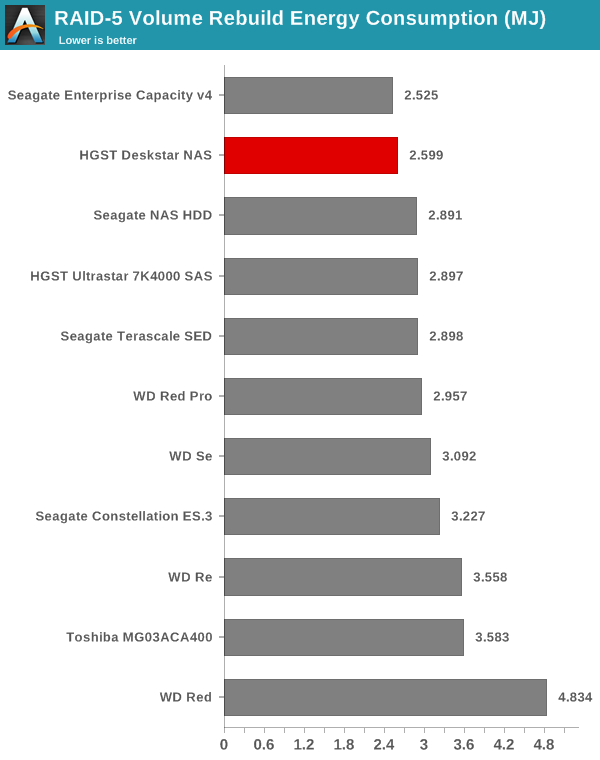
While the energy consumption aspect provides a consolidated view of the various factors, it is still worthwhile to look at the power consumption and resync duration numbers separately. The table below provides the raw information behind the above graph. The HGST Deskstar NAS is not the most power efficient, but makes up for the higher power consumption by getting the job done much faster than the drives with better power numbers.
| RAID-5 Resync Power Consumption & Duration | ||
| Drive | Power (W) | Duration (s) |
| HGST Deskstar NAS | 100.25 | 25922 |
| WD Red | 87.7 | 55125 |
| WD Red Pro | 102.72 | 28787 |
| Toshiba MG03ACA400 | 99.84 | 35886 |
| WD Se | 102.07 | 30293 |
| Seagate Enterprise Capacity v4 | 98.38 | 25670 |
| Seagate NAS HDD | 92.82 | 31149 |
| Seagate Terascale SED | 92.8 | 31230 |
| WD Re | 102.09 | 34850 |
| Seagate Constellation ES.3 | 102.37 | 31520 |
| HGST Ultrastar 7K4000 SAS | 98.35 | 29456 |
We also measured power consumption during the last stage of our multi-client test. With 25 different clients simultaneously stressing the NAS with different types of workloads, we recorded the power consumption at the wall for the NAS as a whole. The various numbers are presented in the graphs below.
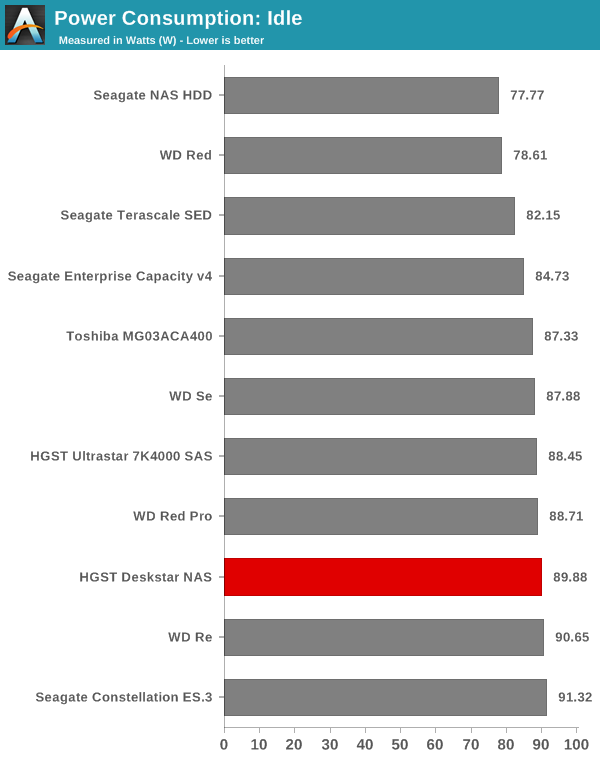
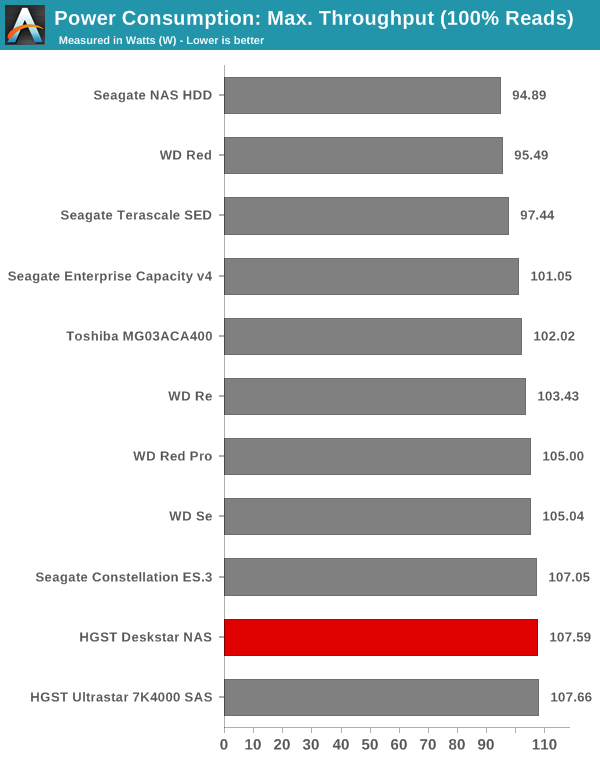
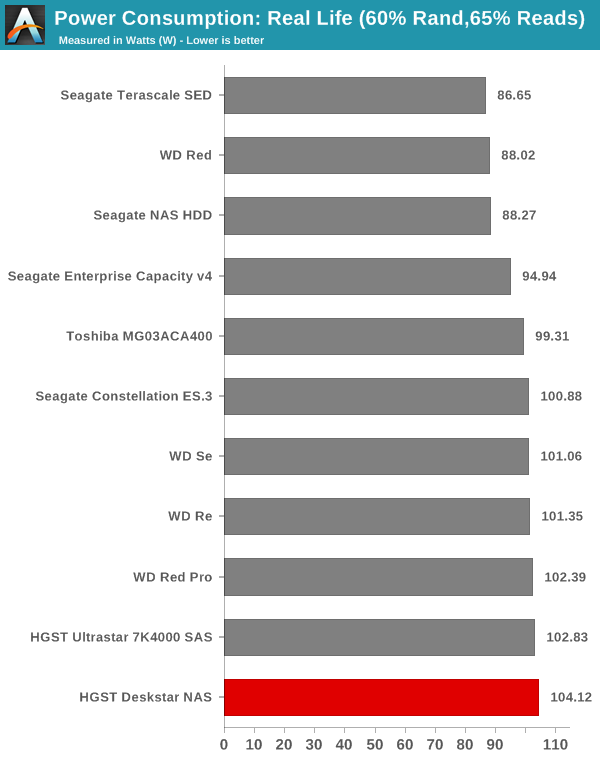
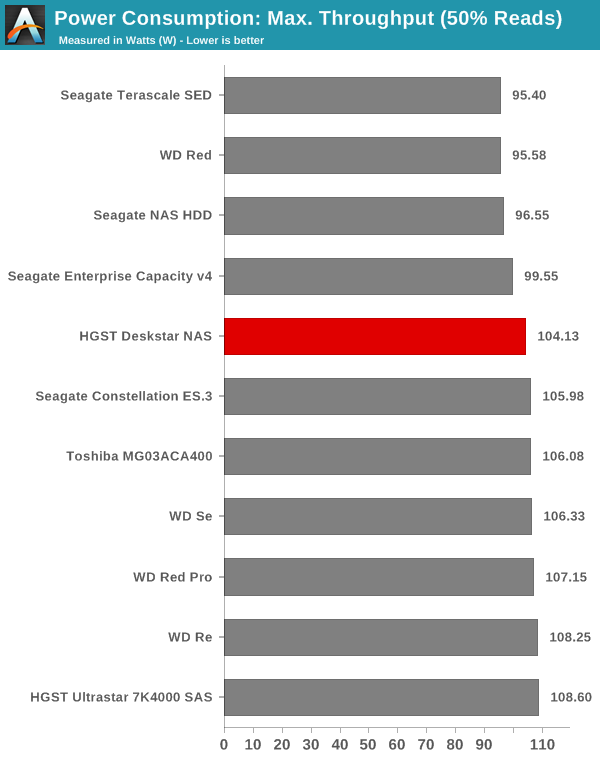
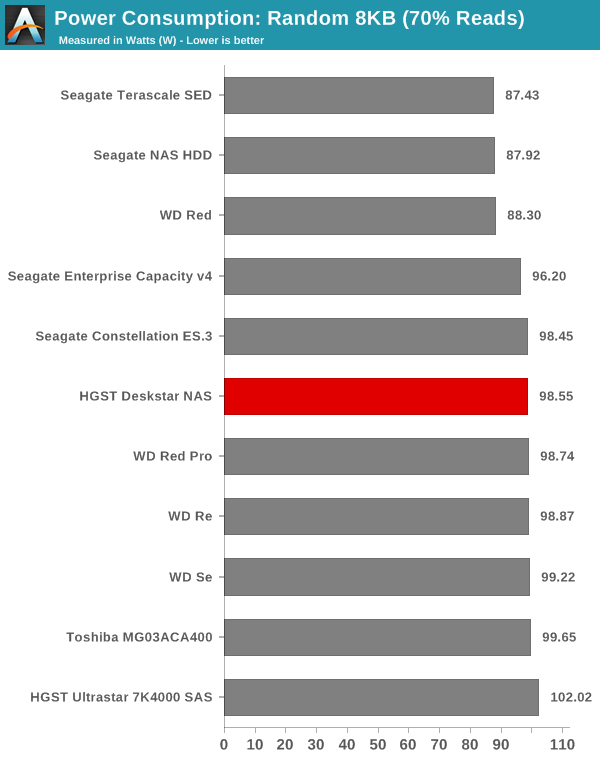
As expected, the units providing better performance have higher power consumption numbers. The HGST Deskstar NAS could be a bit more power efficient, particularly since units such as the Seagate Enterprise Capacity v4 manage to deliver similar / better performance with a better power consumption profile.










39 Comments
View All Comments
cen - Saturday, November 22, 2014 - link
Bought 4 of these for my home NAS and they really are great for the price. The only negative thing is the noise.. I wouldn't have 4 of these in my room for sure.Laststop311 - Sunday, November 23, 2014 - link
I use a 2TB version of this drive in 1 of my pc's and I don't notice any offending noise. The case does have noise dampening foam all around it and the hard drive is elastically suspended and isolated from the frame but I use all noctua fans and a fanless psu so if the HDD was making a lot of noise it should be audible. Maybe it's just your set up. You need to properly suspend the drive off the case with rubber so no vibrations are transferred to the case which is the main cause of noise.Laststop311 - Sunday, November 23, 2014 - link
Maybe the GPU drowns it out but even when the GPU is not in use i still don't hear the HDD even with large file transfers with no gpu activitycen - Sunday, November 23, 2014 - link
You only use a single one, I have 4 of these. This is a big difference.ddriver - Sunday, November 23, 2014 - link
Well, you do have an even number of disks, arrange them the right way and their noise will cancel out ;)melgross - Sunday, November 23, 2014 - link
That would be nice, if it actually worked.ddriver - Sunday, November 23, 2014 - link
Yeah, except it would generate extra heat. If the drives operate in synchrony theoretically they could be arranged in such a manner that their noise cancel out, but it be quite the feat of engineering. It would be tremendously easier to simply dampen and absorb the noise.Zertzable - Sunday, November 23, 2014 - link
Is that why datacenters are so quiet? ;)jota83 - Monday, November 24, 2014 - link
I am getting 60 of those by the end of the week :) Let's see how they perform within a JBOD (Quanta M4600H)NightShade00013 - Saturday, January 16, 2016 - link
I just got done doing a burn in with five of these for my FreeNAS and inside a 4U sitting on my kitchen table the fans were louder than the drives by far. The case is a rosewill RSV-L4500, the two rear 80mm fans have been changed out to PWM fans but the 120's are the ones that came with the case. Not that it's loud at all but the drives were the least on my mind.Burn test was done with BadBlocks and took about 65 hours to run completely. Running a smart long test now and that is the only thing that is a little different. Drives are ranging from 548 minutes to 582 minutes to complete.
Got the drives for less than a 4TB WD Red (not the pro version) so I am loving it. Still need to get two more to finish out my pool but RaidZ3 should be great with a set of seven drives.